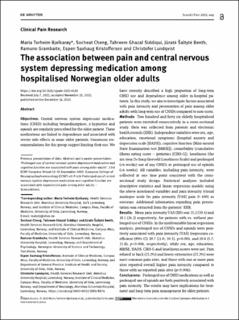| dc.description.abstract | Objectives
Central nervous system depressant medications (CNSD) including benzodiazepines, z-hypnotics and opioids are regularly prescribed for the older patient. These medications are linked to dependence and associated with severe side effects in some older patients. Consensus recommendations for this group suggest limiting their use. We have recently described a high proportion of long-term CNSD use and dependence among older in-hospital patients. In this study, we aim to investigate factors associated with pain intensity and presentation of pain among older adults with long-term use of CNSDs compared to non-users.
Methods
Two hundred and forty six elderly hospitalised patients were recruited consecutively in a cross-sectional study. Data was collected from patients and electronic health records (EHR). Independent variables were sex, age, education, emotional symptoms (hospital anxiety and depression scale [HADS]), cognitive function (Mini-mental State Examination test [MMSE]), comorbidity (cumulative illness rating score – geriatrics [CIRS-G]), loneliness (the six-item De Jong Gierveld Loneliness Scale) and prolonged (≥4 weeks) use of any CNSDs or prolonged use of opioids (≥4 weeks). All variables, including pain intensity, were collected at one time point consistent with the cross-sectional study design. Statistical analyses included descriptive statistics and linear regression models using the above mentioned variables and pain intensity (visual analogue scale for pain intensity [VAS] pain 0–100) as outcome. Additional information regarding pain presentation was extracted from the patients’ EHR.
Results
Mean pain intensity VAS (SD) was 35.2 (30.4) and 18.1 (24.2) respectively, for patients with vs. without prolonged use of CNSDs. In the multivariable linear regression analysis, prolonged use of CNSDs and opioids were positively associated with pain intensity (VAS) (regression coefficient (95% CI) 20.7 (11.0; 30.3), p<0.001, and 19.8 (5.7; 33.8), p=0.006, respectively), while sex, age, education, MMSE, HADS, CIRS-G and loneliness scores were not. Pain related to back (23.2%) and lower extremities (23.2%) were most common pain sites, and those with one or more pain sites reported overall higher pain intensity compared to those with no reported pain sites (p<0.006).
Conclusions
Prolonged use of CNSD medications as well as prolonged use of opioids are both positively associated with pain intensity. The results may have implications for treatment and long-term pain management for older patients. | en_US |

